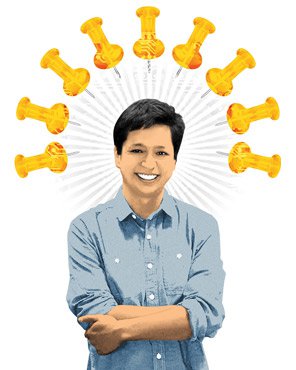Pinterest became a household name seemingly overnight in the spring of 2012. Founder Ben Silbermann had seen what other tech companies were overlooking: existing social networks, while letting users share information in just about any form, did not offer an emotionally warm and visually rewarding experience tied to individual passions. Guided by this conviction and his interest in collecting things, Silbermann directed his engineers—he’s no programmer—to create a site that did.
Users of Pinterest create and curate virtual boards of photos clipped from websites and other users’ boards, gathering up shots of lusted-after products and other stimulating images. When you log in, you’re presented with a grid of new content that past activity suggests you might want to “pin” to your own boards. Silbermann describes it as a more interactive and social version of the lifestyle section of a newsstand: a place to find visually interesting, emotionally resonant content related to stuff you love—and often want to buy.
That vision initially gained momentum not at the elite colleges and California coffee shops that often function as the Web’s proving ground for new ideas but by word of mouth in Silbermann’s home state of Iowa. Perhaps as a result, Pinterest is big with the mainstream audience that other Web companies struggle to attract after they’ve conquered Silicon Valley. It’s used by 34 million people worldwide each month, mostly in the United States. Google’s DoubleClick advertising unit estimates that 79 percent of them are female.
Silbermann refined the idea for two mostly unpromising years after he talked a few friends into starting the company, running it from his own apartment until he received his first significant backing from investors in the summer of 2011. Though he initially had no users to offer feedback, he sweated countless details, having his lone designer, cofounder Evan Sharp, create 50 fully functional versions of the site’s basic layout that varied spacing and image sizes by just fractions of an inch. Silbermann personally wrote to the first few thousand users to gather their impressions.
Now with over 60 employees and a spacious office in San Francisco, Pinterest has received a total of $138 million in venture capital funding; in the last cash injection, the company was valued at $1.5 billion. Silbermann says he’s focused on improving the product rather than figuring out how to make money on it. But retail brands are discovering that they can use Pinterest to boost sales by encouraging people to share images of their products on what are essentially eye-catching shopping wish lists. And that would seem to leave the company well positioned to start charging brands for the privilege. There’s a lot of value in, as Silbermann puts it, “helping people to discover things that they didn’t know they wanted.”
—Tom Simonite




